Concepts and strategies to control gastro-intestinal parasites of ruminants
During a long and continuously active life CSIR/CSIRO’s Hugh Gordon made enormous contributions to the veterinary profession in Australia and to veterinary parasitology worldwide. His research in veterinary parasitology over half a century has had an abiding influence on the field. Undoubtedly, Hugh Gordon’s most important contribution was to lay the foundations of modern epidemiological thinking in the control of helminthoses of grazing ruminants in general and sheep in particular. He applied these ideas to understanding how parasitic diseases and production losses were generated and to developing the principles of preventive control systems, from which he formulated and disseminated the first practical control schemes for use by graziers.
The impact of Hugh Gordon’s research was truly global and his epidemiological work in the 1940s and 1950s influenced the thinking of his contemporaries in Britain and the United States. He received several honours and awards including Member of the Order of Australia (AM) in 1986, Fellowship of the Australian Veterinary Association in 1959, Fellowship of the Australian Society for Parasitology in 1972 and Foundation Fellowship of the Australian College of Veterinary Scientists (also in 1972). He received the Order of the Golden Fleece by the California Wool Growers Association in 1970 and the Gilruth Prize, the most prestigious award given by the Australian Veterinary Association, in 1965.
Early years
When Hugh Gordon joined the new McMaster Laboratory in 1931 to work under the leadership of Ian Clunies Ross, veterinary parasitology was still pretty much in its descriptive phase while Australian woolgrowers were suffering enormous losses from internal parasites in their sheep, especially the trematode Fasciola hepatica,and the nematodes Haemonchus contortus and Oesophagostomum columbianum. This was due partly to a lack of effective anthelmintics but also to a lack of knowledge of how damaging levels of infection came about and how to prevent these. His earliest research was incorporated in the book published jointly by Clunies Ross and Gordon in 1936 [Clunies Ross I, Gordon H McL. 1936, ‘The Internal Parasites and Parasitic Diseases of Sheep: Their Treatment and Control’, Angus and Robertson, Sydney].
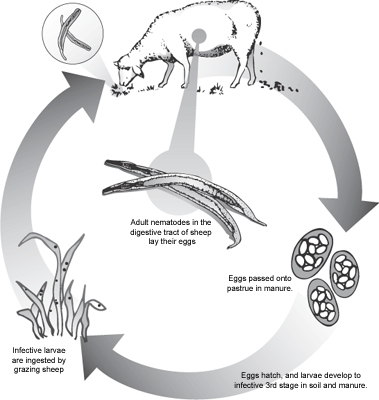
Development and evaluation of anthelmintic drugs
A major theme in Hugh Gordon’s research was the development and evaluation of anthelmintic drugs, employing both laboratory-based tests for spectrum of efficacy and field evaluation of their effects on sheep health and production. He was responsible for the development in the late 1930’s of phenothiazine as a safe and effective anthelmintic for sheep, replacing the bluestone, nicotine and arsenic drenches that were being used in the industry. Phenothiazine remained the basis of worm control in the Australian sheep industry until the 1960’s when the broader-spectrum anthelmintics such as thiabendazole, became available. He played a crucial part in the introduction of both of these compounds which, in their turn, represented quantum leaps in broad-spectrum efficacy over their predecessors.
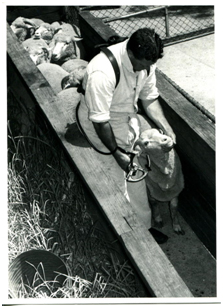
The one serious drawback of phenothiazine was permanent staining of wool. In the 1940s, Harold Whitlock invented the concept of an oesophageal tube incorporated into a drench gun to deliver the dose of phenothiazine beyond the sheep’s mouth. The commercially produced gun shown here contained a plastic retractable tube that was first passed through the sheep’s mouth into the oesophagus by a twisting action of the handle, and only then would the dose be delivered by compressing the trigger. This prevented any spillage of phenothiazine from the sheep’s mouth and onto the fleeces of other sheep in the drenching race. The gun was manufactured and sold by N J Phillips P/L, which is still in business in 2012, supplying drench guns for sheep along with other related products.
Control strategies based on epidemiological studies
However, Hugh Gordon’s major contribution was in the understanding of the epidemiology of the internal parasites of sheep throughout Australia and the use of this knowledge in developing control strategies that minimised the reliance on drenching. He always placed great emphasis on the role of sound animal husbandry practices in controlling and preventing disease. Hugh believed that “the propagation and promulgation of technical information should not have to await the stimulus of urgency or near disaster, but must go on as a gospel preached in good times to provide for the futureâ€.
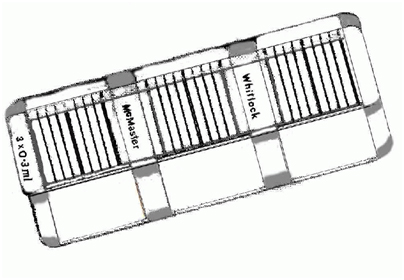
Gordon’s most influential publications appeared in the decade from 1948, mostly as substantial papers in the Australian Veterinary Journal. These papers originated concepts and reported basic findings that are now taken for granted. In them he emphasized the need to separate parasitic gastroenteritis into the different disease entities attributable to individual species if these were to be properly understood and controlled. He introduced the familiar descriptors of predominantly summer, non-seasonal and winter rainfall regions and defined the species of sheep parasites most likely to be pathogenically important in each region. He developed the bioclimatograph as a broadly applicable means of explaining the geographical distribution and seasonal occurrence of the major species based on rainfall and temperature which affect the development of their free-living stages.

He adapted general epidemiological theory to the special case of strongyloid nematode parasites where each parasite in the host has been separately acquired as a free-living infective stage. He analyzed the role of stages and phases of life cycles in explaining the population dynamics of strongyloid nematode parasites and the points of attack in controlling them. All of this conceptual development was founded on and supported by the results of substantial field studies and laboratory experimentation, including some of the first work on the effects of developing host resistance on parasitic infections in sheep and their interactions with nutrition and management, often in collaboration with colleagues.
In the development of control systems for the helminthoses of sheep, Hugh Gordon introduced the concepts of ‘strategic’ and ‘tactical’ drenching. From the beginning he emphasized the preventive importance of strategic treatments based on the seasonal pattern of infection and directed primarily at reducing pasture contamination at critical times. He also placed great importance on combining the use of anthelmintics with flock and pasture management. Based on these principles, he promoted the first seasonal drenching program for sheep in summer-rainfall regions in the1940s and later put forward similar programs for the non-seasonal and winter rainfall regions.
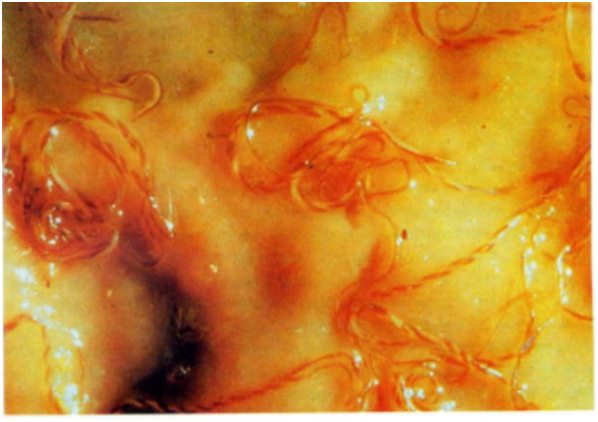
Over the following two decades, several influences resulted in changes to the details of worm control programs for sheep. Later research brought a fuller understanding of the seasonal and regional variations in rates of development and survival of parasite free-living stages on pasture and hence in infection rates for sheep, revealed particularly as slower development rates and longer survival times on pasture than had been believed hitherto, These findings were followed by studies on the role of different forms of grazing management in worm control. New knowledge was gained of the regulation of worm populations in the sheep, particularly the lambing ewe. At the same time the problem of resistance in the parasites to anthelmintics (‘drench resistance’) began to emerge as a serious problem. Also, new broad- and narrow-spectrum anthelmintics became available.
From all of this came three, revised integrated worm control schemes that were promoted to graziers in the 1980s ‘ ‘Wormkill’ for summer-rainfall regions, the ‘Two-Summer-Drench’ program for winter-rainfall regions, and ‘Drenchplan’ for non-seasonal rainfall regions. All three schemes emphasized the use of a limited number of strategically-timed drenches, for different classes of stock, designed to have most effect while attempting to limit selection for drench resistance. For the winter rainfall and non-seasonal rainfall zones, two drenches in summer were crucial to minimize contamination of pastures with worm eggs in summer and autumn because this is the primary source of infections in autumn, winter and spring. All schemes recommended using grazing management where possible, meaning moving lambs and weaners to ‘low worm’ pastures after drenching. ‘Low worm’ pastures were defined as those not grazed by sheep since before the previous summer, or grazed only by adult dry sheep or cattle since the previous drench, or in paddocks that have been cropped, cut for hay, or have a new pasture.
All these schemes were based on the principles first developed by Hugh Gordon. Moreover, much of the research, and the formulation of the control programs, was done by his younger colleagues in CSIRO – Norman Anderson, Keith Dash, Alan Donald, Fred Morley, Bill Southcott and Peter Waller – who also had been his undergraduate students at the Sydney Veterinary School. As Alan Donald recalled:
‘Fred and Bill were 1940s graduates, Hugh having taken over the teaching of parasitology in the vet school from Ian Clunies Ross in 1937. Norman Anderson and I were 1950s graduates, Keith Dash and Peter Waller from the 1960s. Norman was based at the Parkville lab of Animal Health and led the Victorian research in the winter rainfall zone, Bill and Keith were at the Pastoral Research Lab, Armidale working in the summer-rainfall zone. Peter and I were at the McMaster Lab and, through the decade of the 1970s, collaborated with Fred Morley’s group in Plant Industry in Canberra. Fred headed the Agricultural Systems group in PI and our collaboration was around the role of grazing management in optimizing livestock production including parasite control, in the non-seasonal rainfall zone.’
National and international impact
The impact of Hugh Gordon’s research was truly global. His epidemiological work in the 1940s and 1950s was clearly influential in the thinking of his contemporaries such as HD Crofton and EL Taylor in Britain and Norman F Baker and John H Whitlock in the United States. Other important topics to which he contributed through hypothesis and experiment were the ‘self cure’ phenomenon, the peri-parturient rise of helminth egg output in the ewe, and hypobiosis or arrested development in nematodes.
He was a foundation member of the World Association for the Advancement of Veterinary Parasitology (WAAVP), a member of its Executive Board and served for a period as its First Vice-President. In 1981 he was elected an Honorary Member of the WAAVP and also of the Helminthological Society of Washington. He was elected a Fellow of the Australian Veterinary Association in 1959, a Fellow of the Australian Society for Parasitology in 1972 and was a Foundation Fellow, Australian College of Veterinary Scientists (also in 1972).
He was awarded a Member of the Order of Australia (AM) – for services to Veterinary Science in 1986, the Order of the Golden Fleece by the California Wool Growers Association in 1970 and the Gilruth Prize in 1965, the most prestigious award given by the Australian Veterinary Association. The Gilruth Prize is named after CSIR’s John Anderson Gilruth, the Foundation Chief (1930-35) of CSIR’s Division of Animal Health.
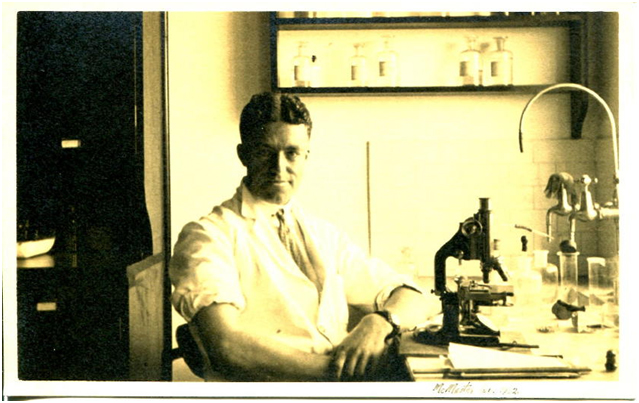
As former student and CSIRO colleague Alan Donald wrote in his obituary for Hugh Gordon in 2002 (see Source below):
‘For those who knew and worked with Hugh Gordon, he was a delightful teacher, mentor, colleague and friend. He had a truly enquiring mind, a constant capacity for lateral thinking, and an encyclopedic knowledge of many things but of matters parasitological above all. For many years, he surveyed the current parasitological literature for the McMaster Library indexing system and would often draw interesting papers to the attention of his colleagues. He was always approachable by the most junior of his colleagues or students and was never too busy to answer their requests for help or advice.
Many will remember tapping on the half-open door of his room at the McMaster to be invited immediately to come in, and to find Hugh at his desk literally surrounded by enormous piles of journals, books and papers ‘ but instantly able to put his hand on the item that would help you with your problem. Right up to the last years of his life, Hugh Gordon continued to keep in touch with his colleagues and with progress in veterinary parasitology’.
Source
- Donald AD, 2013, personal communication
- Donald AD, 2002, “Obituary Hugh McLeod Gordon’, Aust Vet J, 80: 573.
- Plant JA, 2002, ‘A Tribute to Hugh Gordon’. Aust Vet J, 80:328.
